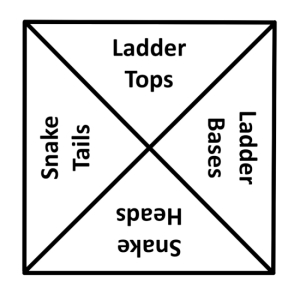 My propositions are elucidatory in this way: he who understands me finally recognizes them as senseless, when he has climbed out through them, on them, over them. (He must so to speak throw away the ladder, after he has climbed up on it.) He must surmount these propositions; then he sees the world rightly.
My propositions are elucidatory in this way: he who understands me finally recognizes them as senseless, when he has climbed out through them, on them, over them. (He must so to speak throw away the ladder, after he has climbed up on it.) He must surmount these propositions; then he sees the world rightly.
— Ludwig Wittgenstein, from Tractatus Logico-Philosophicus 6.54
Consider the children’s game of “Snakes and Ladders”.
The object of the game is to traverse a sequence of locations on a game board, numbered from one (the beginning) to some maximum goal (the end), with the numbers increasing from the bottom of the board to the top. The player usually competes with other players to win the goal first, because otherwise why do it. Ladders join lower numbers at their base with higher numbers at their top. Snakes join higher numbers at their head with lower numbers at their tail.
The players take turns and each move forward a number of locations determined with a roll of a die. If a player lands on the bottom of a ladder, she can immediately climb to the top of it, skipping the locations in between. However if she lands on the head of a snake, she must slide down the snake to its tail, essentially losing her recent gains of several turns.
The game progresses by chance, and indeed the winner is completely chosen by luck. There are no choices that players can make to increase their chance of winning the game, and so it is completely random. It is evidently an ancient game and older versions often portrayed the ladders as virtues and the snakes as vices. What can this game teach us about morality and life in general?
Unfortunately the player cannot gain knowledge or experience along their journey to help them. There is no way to increase one’s chance to land on a ladder’s bottom or decrease one’s chance to land on a snake’s head. The game is on the other end of the spectrum from a choice driven game such as tic-tac-toe, or even chess. I’m also reminded of the card game “War”, which is another random game played by children. Such completely random games equalize chances of winning among different ages, I imagine.
From Wikipedia: The game (Snakes and Ladders) is a central metaphor of Salman Rushdie’s Midnight’s Children. The narrator describes the game as follows:
All games have morals; and the game of Snakes and Ladders captures, as no other activity can hope to do, the eternal truth that for every ladder you hope to climb, a snake is waiting just around the corner, and for every snake a ladder will compensate. But it’s more than that; no mere carrot-and-stick affair; because implicit in the game is unchanging twoness of things, the duality of up against down, good against evil; the solid rationality of ladders balances the occult sinuosities of the serpent; in the opposition of staircase and cobra we can see, metaphorically, all conceivable oppositions, Alpha against Omega, father against mother.
Notes:
Actually, it reveals the fourness of things. The snake tails and ladder tops are different in kind from the snake heads and ladder bases, because landing on the former the player doesn’t change position. She can instead contemplate possibly backsliding and revisiting this location via snake or the experiences of having taken the long way instead of just climbing to this location via ladder.
A more modern version could replace the snakes and ladders with one entity, perhaps wormholes, which would deliver one instantly to the opposite end, either forward or backward. The name could be revised to “Shortcuts and Backtracks”, perhaps. Or maybe it would be too confusing.
References:
http://en.wikipedia.org/wiki/Snakes_and_Ladders
http://en.wikipedia.org/wiki/War_%28card_game%29
[*8.144, *9.102]
<>
 I have added the eighth, which is the actual silence of all one cannot speak of. Quite a large section, for all its emptiness.
I have added the eighth, which is the actual silence of all one cannot speak of. Quite a large section, for all its emptiness.



